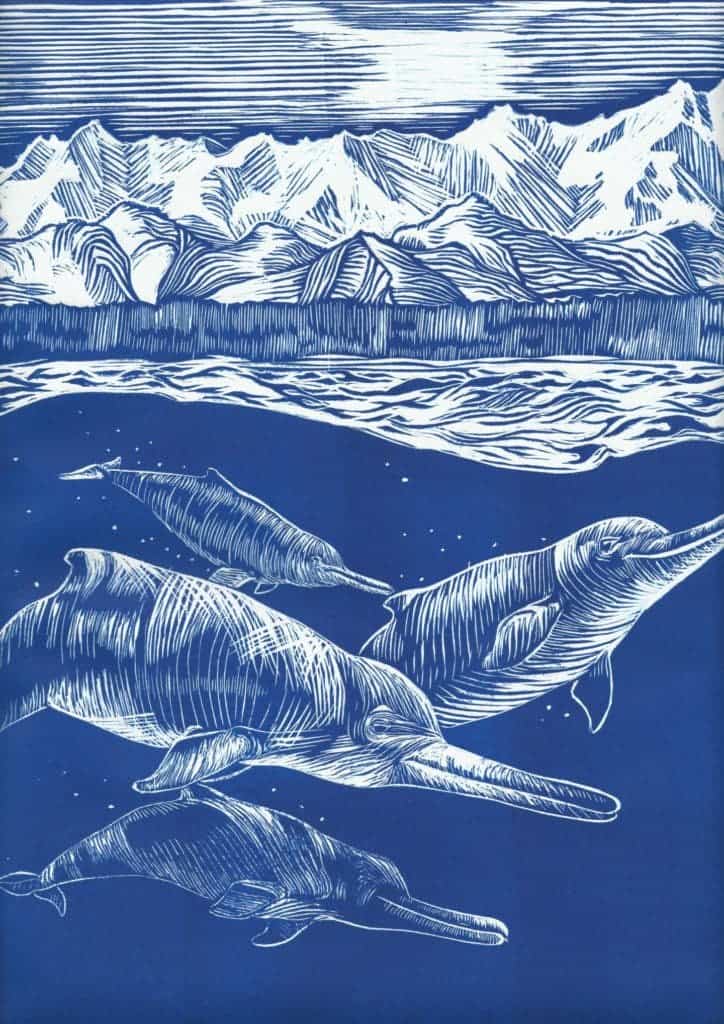A fossil that has been lying in the Smithsonian collection for more than 50 years may help piece together an evolutionary puzzle of dophin and whales.

Artistic reconstruction of a pod of Arktocara yakataga, swimming offshore of Alaska during the Oligocene, about 25 million years ago, with early mountains of Southeast Alaska in the background. The authors speculate that Arktocara may have socialized in pods, like today’s oceanic dolphins. Art by Alexandra Broesma.
The fossil, a partial skull about 9 inches long, was discovered in southeastern Alaska by Donald J. Miller, a geologist with the United States Geological Survey, back in 1951. It was carefully stored in the museum collection, alongside tens of thousands of other specimens and largely forgotten. Nicholas D. Pyenson, the museum’s curator of fossil marine mammals, and Alexandra Boersma, a researcher in his lab, finally got to analyze the fossil, writing that it belonged to a dolphin that swam in subarctic marine waters around 25 million years ago, during a period called the Oligocene. It represents not only a new species, but also a new genus – a superior taxonomic rank.
“We are always learning new things about the vast legacy built by our predecessors at the museum,” Pyenson said. But earlier this year, he and Boersma were captivated by and focused their attention on what Boersma calls “this beautiful little skull from Alaska.”
It happens more often than you think: researchers find a throng of fossils, but with limited funds and time, many of them lie undescribed. If you’ve ever seen a museum collection, you probably know what I mean. Huge, warehouse-like rooms are filled with fossils and there’s no way a handful of people could ever analyze them properly. Even valuable specimens such as this one are sometimes forgotten, unseen not only by patron museums but also by staff.
“There’s all this stuff that no one has ever had time to go through,” Alexandra Boersma, who studies fossil marine mammals at the Smithsonian, told The Washington Post. “Some of it has been sitting there for decades,” Boersma adds. “No one has gotten around to describing it.” Sometimes, all you need to do to find a new species is wander on the museum halls.
They named the fossil Arktocara yakataga. After comparing its features to both living and extinct dolphin species, they learned that it is a relative of the South Asian river dolphin Platanista. This used to be a large and diverse group of dolphins, but today, Platanista is the only survivor. So the entire legacy of A. yakataga hangs by a thread. Platanista is poorly understood and tragically endangered, threatened by fishing nets, pollution and habitat destruction with only a few thousand specimens surviving in the waters of Nepal, India, Bangladesh and Pakistan.
Paleontologists hope that by studying this older fossil, we can better understand Platanista’s needs and vulnerabilities, tailoring better strategies to ensure its survival.
“One of the most useful ways we can study Platanista is by studying its evolutionary history, by looking at fossils that are related to it to try to get a better sense of where it’s coming from,” Boersma said. “Exactly how that once diverse and globally widespread group dwindled down to a single species in Southeast Asia is still somewhat a mystery, but every little piece that we can slot into the story helps.”
For starters, the fact that today’s dolphin lives in waters in eastern Asia and the Oligocene dolphin lived in Arctic waters is a surprise.
“Considering the only living dolphin in this group is restricted to freshwater systems in Southeast Asia, to find a relative that was all the way up in Alaska 25 million years ago was kind of mind-boggling,” Boersma said.
Journal Reference: Arktocara yakataga, a new fossil odontocete (Mammalia, Cetacea) from the Oligocene of Alaska and the antiquity of Platanistoidea.









